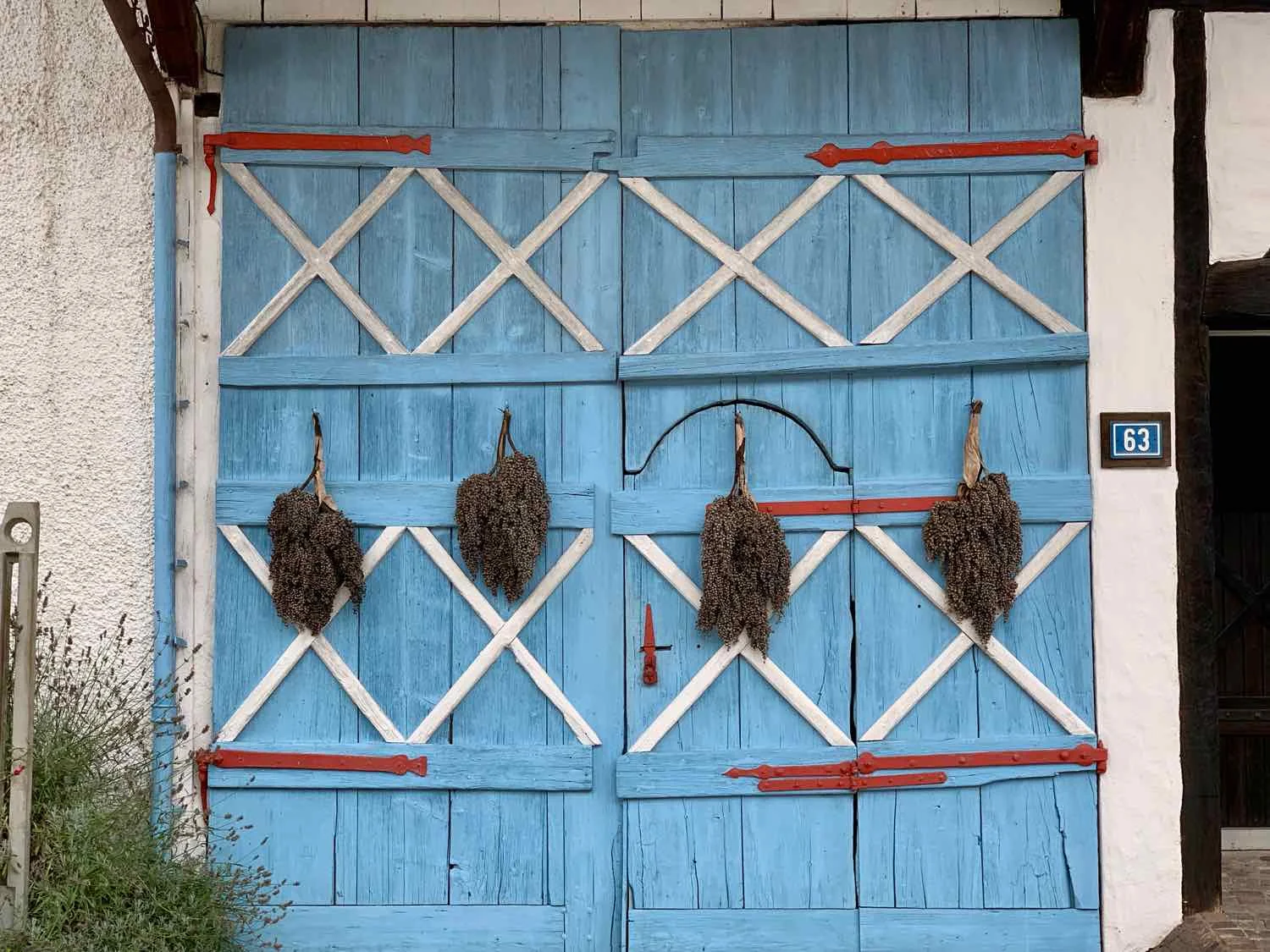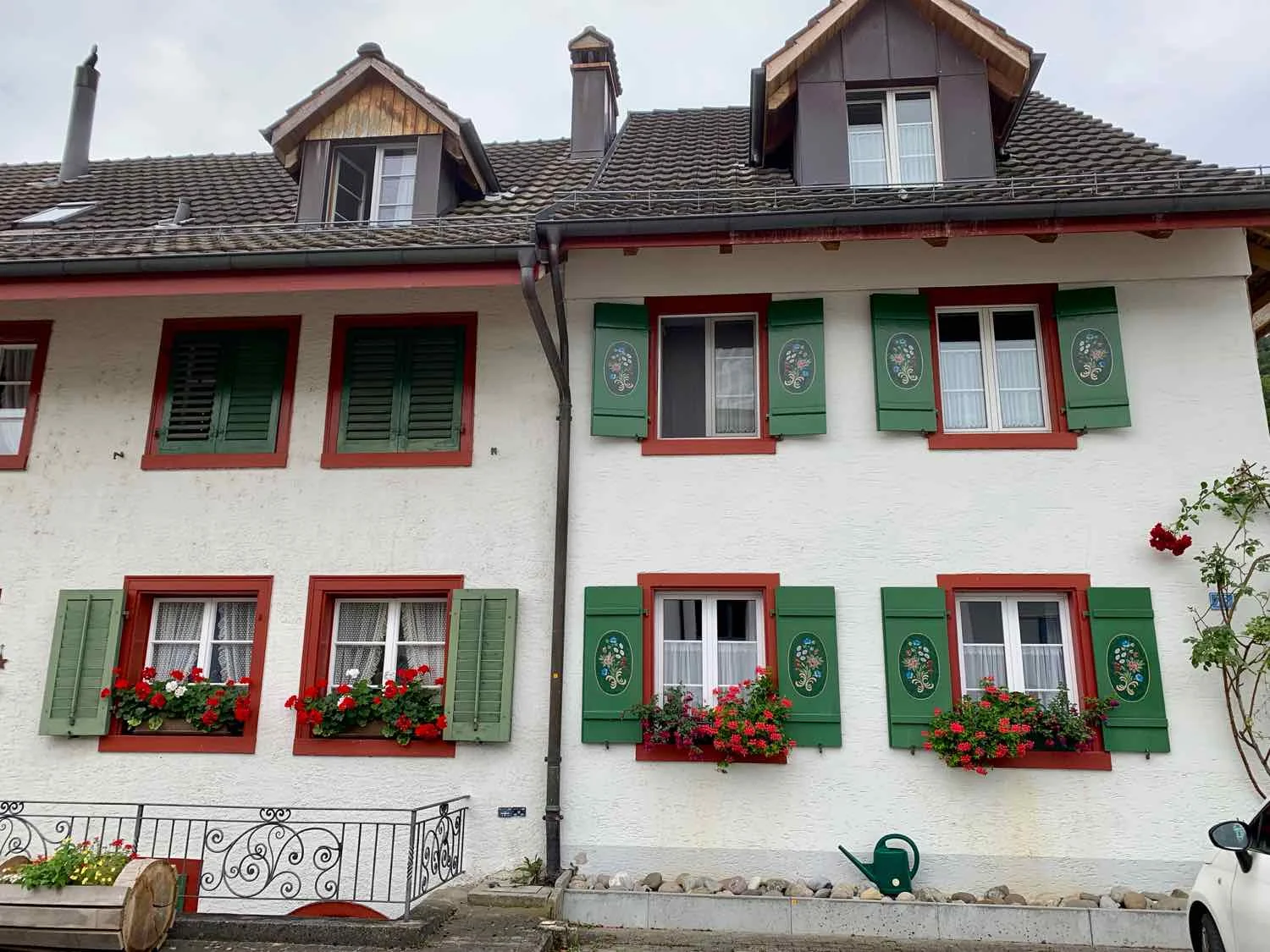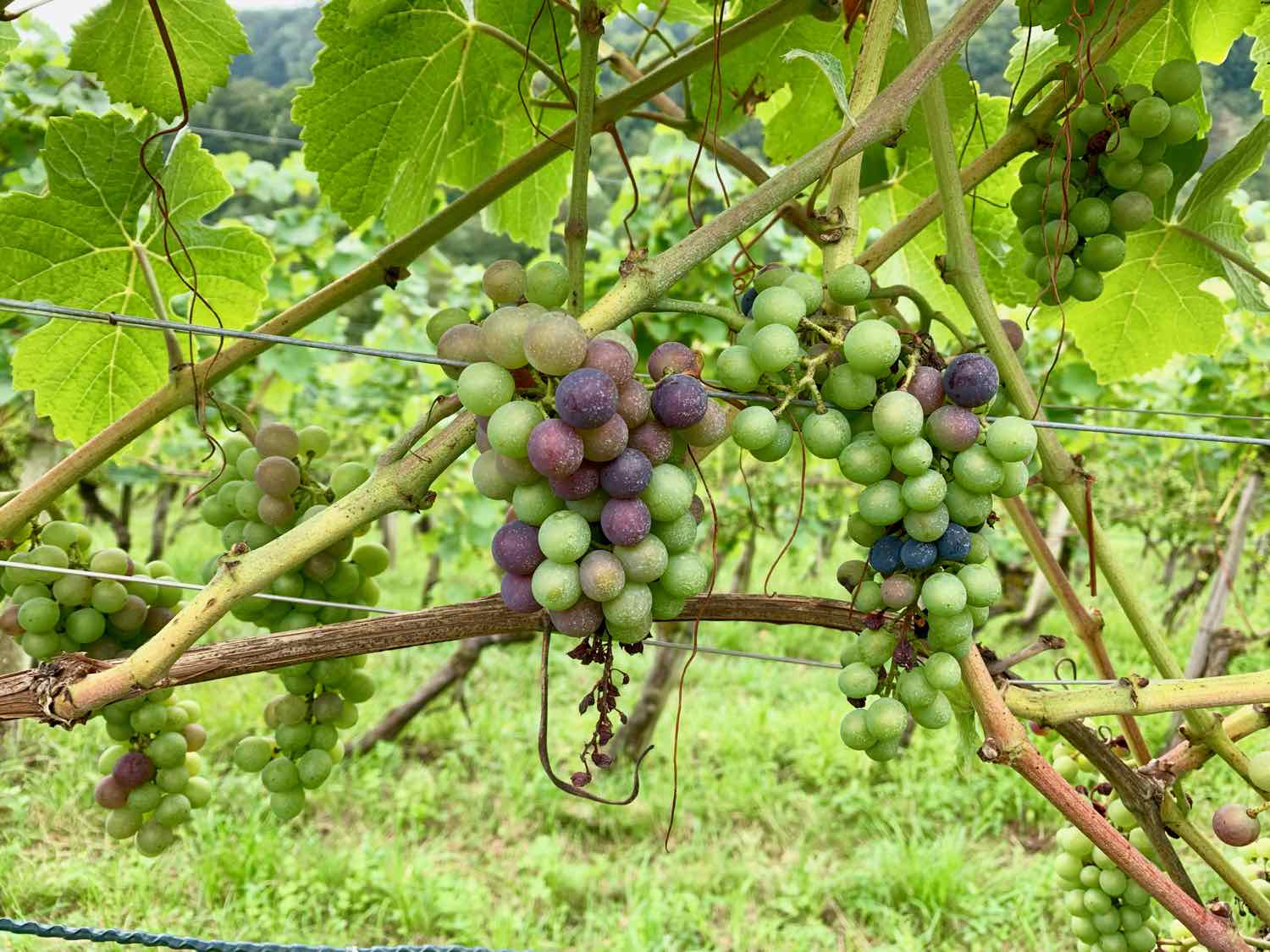Hohentengen am Hochrhein to Tuttlingen, Germany: Cycling Over Europe’s Continental Divide
17 - 19 August 2019
Hohentengen am Hochrhein, Germany to Stein am Rhein, Switzerland (17 August 2019, 64 km, 39.8 mi)
PedalingGuy did a great job of navigating us back to the EuroVelo 6 route this morning. We started the day on the German side of the Rhine, and had to find a way to get back across the river into Switzerland to rejoin our route. We headed towards a big hydro-electric dam near Rheinsfelden that looked on the map like it had a bridge. But as we approached the dam, it wasn’t obvious that there would be a way for us to get across. Then, just as we were starting to think that the crossing was closed to the public, a small group of cyclists on road bikes came riding towards us, apparently having just come off of the dam. That gave us hope, and we cycled onward. The narrow, concrete pathway across the dam didn’t really look like a public access road, but it wasn’t blocked off, either. So we cycled across, happy to make it back into Switzerland.
We made it safely back to the EuroVelo 6 route, across the Rhine River in Switzerland, by crossing a narrow path over this dam. Rheinsfelden, Switzerland. Copyright © 2018-2019 Pedals and Puffins.
The ride was more challenging today than it’s been in a while. There were a whole lot of hills. The Rhine Valley gets quite narrow in some places, as the mountains of the Black Forest and Swiss highlands nudge their way right up to the edge of the river. That forced the cycle route up into the surrounding hills. And, just like the Appalachians, they are steep even though they’re not very long.
In many places the Rhine River cuts a narrow path through the Black Forest and Swiss Highlands, creating steep-walled valleys. For a bike route, that means a lot of ups and downs. Rheinsfelden, Switzerland. Copyright © 2018-2019 Pedals and Puffins.
For the first 10 km, we were on a winding, hilly road that curved back and forth through a dense forest. The road was very popular with people on motorcycles, who clearly enjoyed negotiating the twists and turns while going very fast. It seemed like every couple of minutes we were being passed by another group of roaring motorcycles. We were lucky that there wasn’t too much other traffic, so that there was plenty of space for them to zoom around us without getting too close.
Descending off of the ridge, we cycled through more picturesque, riverside towns. The basic Swiss house tends to be rather plain, being white with dark, brown cross timbers. But the doors and windows offer residents a chance to express themselves with bright colors, delicately-decorated shutters, and window boxes overflowing with exuberant flowers. The overall effect is very pretty.
Crossing the Töss River where it flows into the Rhine. Tössegg, Switzerland. Copyright © 2018-2019 Pedals and Puffins.
Today we encountered our first Rhine Valley vineyards. White riesling grapes are common here, as they are elsewhere in Central Europe. But reds are also popular, including Pinot Noir. We’ve cycled past a lot of vineyards in Europe, but these were the first where we’ve seen clusters of grapes on the vines. The wine-harvesting season must be just around the corner. The fruit looked plump and juicy, tempting us to pluck one for a taste. But we resisted.
Taking a break by the public water fountain. Teufen, Switzerland. Copyright © 2018-2019 Pedals and Puffins.
We ate our breakfast at an overlook, high above a sharp bend in the Rhine River. The spot wasn’t right next to the road - it was down a long, single-track, gravel path towards the river. The view from the mountainside was spectacular, with the emerald-green river cutting its way through the forested hills. While we were there, two other bikers spotted us from the road, and came out to enjoy the view, as well. We seem to have started a trend.
The Rhine River, bordered by Germany’s Black Forest. Teufen, Switzerland. Copyright © 2018-2019 Pedals and Puffins.
The forests here are thick and lovely. Seeing them made us realize how degraded most of the forests were that we saw in France. Even though there is plenty of tree-harvesting forestry here, the trees are generally older, and the species are much more diverse. The forests seem like they’ve been more lightly managed, and allowed to develop more naturally.
We stopped for lunch at a store in the town of Rheinau, that lies within a sharp, hairpin bend in the river. And for the third day in a row, our lunch included chocolate milk. I am in heaven. Chocolate milk is a staple of our biking diet, when we can get it. But low-fat chocolate milk was impossible to find in France. Here in the land of Swiss Miss, chocolate milk is available everywhere, and we buy some almost every chance we get.
Baroque towers of the Rheinau Abbey. The building has been vacant since 2000, but the clocks on the tower still tell the correct time. Rheinau, Switzerland. Copyright © 2018-2019 Pedals and Puffins.
On our way out of town, we caught sight of something strange going on along the river. A group of people were busy hauling a long boat up onto a platform on rails. We stopped to have a look, unsure what the heck was going on. It turns out that the three hydroelectric dams near Rheinau completely block the river channel, so boats can’t get though. Instead, Switzerland built boat lifts around each of the dams. Boaters that want to go around the dam have to disembark, and transport the boat overland using the movable platform. The cables that pull the platform are attached to a big engine, that does all the heavy lifting. But it still looked like a lot of work to get the boat out of the water and onto the platform. All of the lifts belong to Switzerland, and there is actually a small sliver of Swiss territory on the right bank of the Rhine here, to accommodate the boat lift.
Getting ready to transport a boat around the main hydroelectric dam at Rheinau, Switzerland. Passengers get out and haul the boat onto a platform on rails, that is pulled around the dam by an engine and cable system. Copyright © 2018-2019 Pedals and Puffins.
Shortly after that, we suddenly found ourselves cycling through a dense sea of tourists. We had reached Rheinfall at Neuhausen, the park where people go to see the Rhine Falls - the most powerful waterfall in Europe. The area was packed with people out for a Saturday in the park. There might have been some kind of festival going on as well. We couldn’t quite tell. Signs indicated that EuroVelo 6 had been re-routed around the park, sending us over a huge hill, instead of following the original route along the river valley.
One cool thing about going over that hill was that it didn’t have any trees, so we could see far into the distance. And for the first time we saw the Swiss Alps! There they were, in all their snow-capped glory. It was impressive how much snow was still on the higher peaks in mid-August. We were delighted by the view, and spent some time enjoying the vista, taking photos and, incidentally, catching our breath.
The Swiss Alps, as seen from a big hill along the Rhine River. Those mountains are about 100 km (60+ miles) away. Uhwiesen, Switzerland. Copyright © 2018-2019 Pedals and Puffins.
Just look at all that snow. You’d hardly guess it was mid-August. Uhweisen, Switzerland. Copyright © 2018-2019 Pedals and Puffins.
It was a huge, extra expenditure of energy to get over that hill. Even coming down the far side of the hill into Furlingen was difficult, because the gravel road was very steep, narrow and winding. We were glad to finally cross the bridge into Neuhausen. After that, the trail leveled out and we cruised along at a pretty good pace.
Yes, this photo is exactly what it looks like. That big brush on the left is spinning, and the cow is using it to… scratch an itch. We’d never seen anything quite like that before. Along the Rhine River. Copyright © 2018-2019 Pedals and Puffins.
Before long we reached Gailingen am Hochrhein, the town in Germany where we had planned to spend the night. Unfortunately, our mobile data e-SIMs don’t work in Switzerland, so we weren’t able to use the internet to book a hotel in advance. It turns out that Gailingen is in a pretty high-use, tourist area, and we were out of luck. It was a Saturday night, and all of the hotels in town were fully booked.
We stopped near this very long and picturesque covered bridge in Gailingen am Hochrhein, Germany, to try to book a hotel. But we were out of luck. All of the hotels in the area were full. Copyright © 2018-2019 Pedals and Puffins.
After considering our options, we decided to continue down the road for 12 km more, to reach a campground, right on the border between Switzerland and Germany. It’s another one of those campgrounds that’s primarily for permanent and semi-permanent residents in mobile homes, with a lawn area for tent campers. At least we could be pretty sure they’d be able to accommodate us.
Which way to Stein am Rhein? Ah, yes. There’s a sign for EuroVelo 6 about halfway down the pole. Germany sure does have a lot of bike routes. Gailingen am Hochrhein, Germany. Copyright © 2018-2019 Pedals and Puffins.
On the last leg of the day’s ride, we passed the well-preserved, medieval town of Stein am Rhein, Switzerland. The old town lies just beyond that historic gate. Copyright © 2018-2019 Pedals and Puffins.
When we got to the campground, we couldn’t find anyone in charge. The reception office was closed, with no one around. So we pitched our tent, figuring we would pay later. Every hour or so we would go back to the office, but no one ever showed up. It also turned out that the campground and adjacent restaurant were for sale which may have had something to do with no one being around. Luckily the bathrooms were open, with hot water and showers. So we settled in. There was a small convenience store across the road, that had everything we needed for a simple, picnic dinner.
Oddly, the only shade in the campground was provided by fruit trees. The fruit was ripe, and the trees were dropping tennis-ball sized apples, pears and plums. You don’t have to be Sir Isaac Newton to know that you don’t want to put a tent under one of those trees, where you might get hit by a falling apple. Or more likely, you will step on a squishy, rotting plum. We put our tent out in the open grass.
It drizzled off and on all evening, but never rained that hard. We had a little bit of time when we could sit out on our camp chairs, and enjoy our last evening in Switzerland.
Stein am Rhein, Switzerland to Tuttlingen, Germany (18 August 2019, 63 km, 39.2 mi)
We were up and out of our sleeping bags before the sun came up this morning at 6:22am. Sunrise is getting later and later as fall approaches. Although we’re heading east (towards the rising sun), we’re not moving fast enough to offset the arrival of fall.
Our route today passed more fields of beets, string beans and rutabagas, as well as dozens of orchards with apples and plums. In addition to the bigger orchards, we noticed that lots of people have fruit trees in their yards, and in several places the road was lined with apple trees. This area seems especially productive for growing fruit. And between the towns, orchards, and acres of rutabagas, we continued to ride through large areas of forest. It was some of the most scenic riding we’ve enjoyed on this trip.
We really like the Swiss and German tradition of having window boxes, brimming with brightly-colored flowers. This house along the route was particularly spectacular. Radolfzell am Bodensee, Germany. Copyright © 2018-2019 Pedals and Puffins.
Five days ago we saw our first Central European white stork in eastern France. That was just one bird, soaring high in the sky. Here, near the shores of Lake Constance in southern Germany, we have now seen dozens of white storks. Most of them are gliding around overhead, rising ever higher on columns of warm air that will take them as high as 1,500 m (5,000 ft). From there, they will glide for many miles on their southward migration, without having to flap their wings. Pretty smart. We’ve also seen small-to-medium sized groups of storks resting and feeding in open fields, as they gather their strength for the long flight to Africa.
After a quick, picnic lunch under a tree just past Eigeltingen, we began the long ascent up and over Europe’s continental divide.
In the US, the Continental Divide is an iconic geographical formation, that everyone has heard of. Located along the spine of the Rocky Mountains, it separates rainfall that flows east to the Atlantic Ocean from water which flows westward into the Pacific Ocean. Perhaps it is the fact that the divide often runs along the crest of snow-capped mountains that makes it striking, and therefore memorable. But it’s definitely something that is familiar to all Americans.
So it’s interesting to us that the Europeans don’t pay much attention to their own continental divide, which separates rainfall that flows northwest towards the Atlantic Ocean and North Sea, from water that flows southeast towards the Black Sea and the Mediterranean. By leaving behind the Rhine River (which flows into the North Sea), and entering the Danube River Valley (which flows east to the Black Sea), we crested Europe’s continental divide. From a practical standpoint, that means that from here on out, our route will be trending downhill, instead of uphill - worth noting when you’re on a bicycle.
The elevation profile for today’s ride. That lump on the right represents biking up and over Europe’s continental divide. From here, all water flows to the Black Sea or the Mediterranean. Copyright © 2018-2019 Pedals and Puffins.
To get from the Rhine to the Danube, we cycled over a ridge in the Swabian Jura mountain range, within the Upper Danube Nature Park. The weather was incredibly sunny and hot. On top of that, the route over the divide goes mostly through agricultural areas. So there was not nearly enough shade. Even though we were riding through a “nature park,” like many parks in Europe, the land was mostly converted to agriculture. The crest of the ridge was covered by corn fields, and topped with a very tall, pointy, radio tower. We stopped at the top to look out over the Danube Valley that lay ahead of us, and snapped a photo of the radio tower at the top.
Here’s what we saw at the top of the ridge on Europe’s continental divide: a radio tower in a corn field. At least we could be sure we had reached a high point on the mountain, because that’s where they would want to put a telecommunications tower. Naturpark Obere Donau, Lohhof, Germany. Copyright © 2018-2019 Pedals and Puffins.
The bike ride downhill into Tuttlingen was much steeper than the climb had been, so we were pretty glad that we were headed east. It would have been a lot harder to climb those hills heading west. As it was, the narrow, winding roads required us to take the downhills slowly, with a lot of braking.
There weren’t many options in town for dinner, because most restaurants and stores were closed Sunday evening. We walked out to the edge of town along the Danube River, to a Burger King, just about the only restaurant that was open. On the way back to our hotel, we passed a small circus taking down their big top tent. It was fascinating to watch their process, where about a dozen guys worked together like a well-oiled machine. They clearly had a lot of practice, and each one knew exactly what his role was. The massive task was completed fairly quickly. And within an hour, the giant tent was folded up into a package the size of a tractor-trailer truck.
Folding up the big top, as the circus prepares to leave town. Tuttlingen, Germany. Copyright © 2018-2019 Pedals and Puffins.
Tuttlingen Rain Day (19 August 2019)
It rained nearly all day today, so we mostly stayed indoors. In the early evening we walked around the town center, taking the opportunity to stretch our legs while there was a break in the weather.
Protestant city church in downtown Tuttlingen, Germany. Copyright © 2018-2019 Pedals and Puffins.








